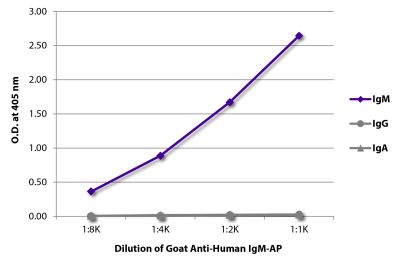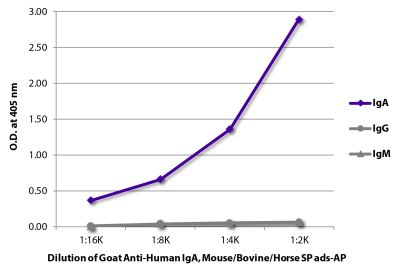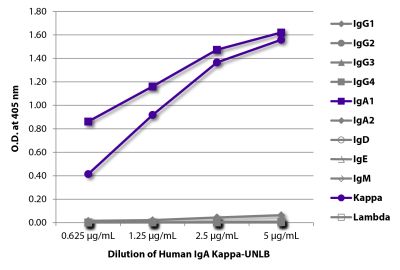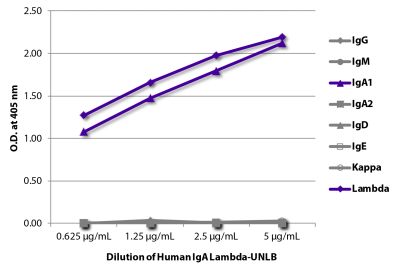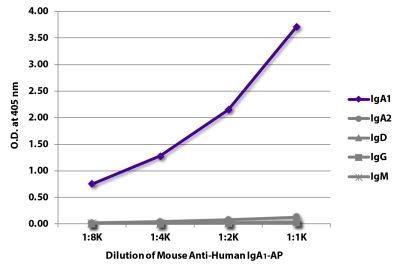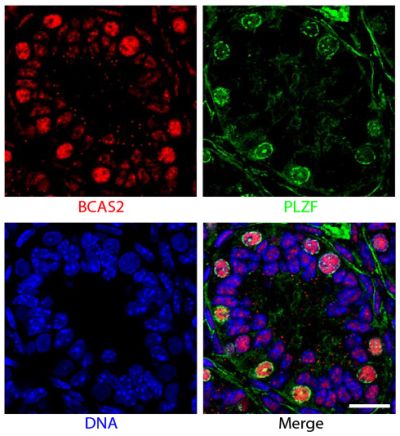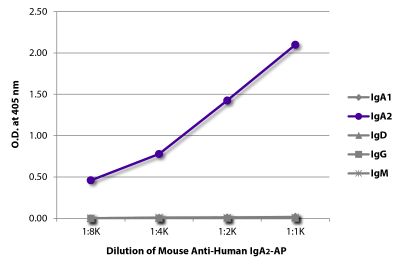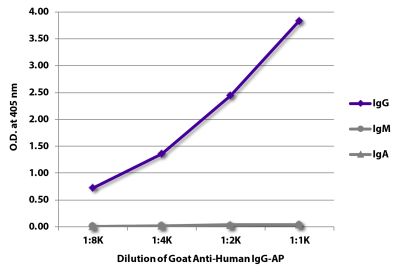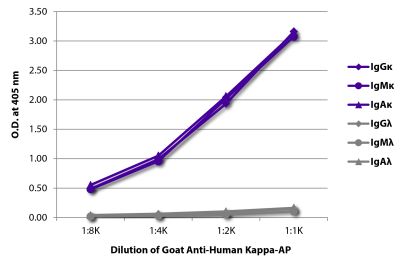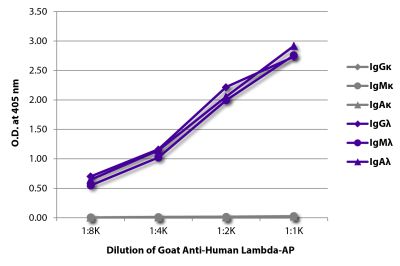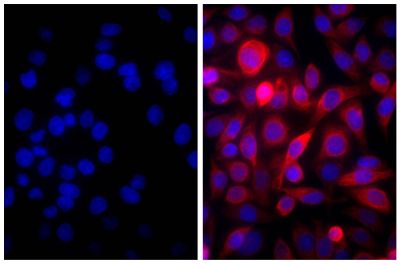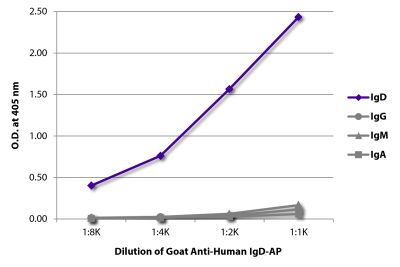Goat Anti-Human IgA-AP
Cat. No.:
2050-04
Goat Anti-Human IgA-AP antibody for use in ELISA, immunohistochemistry / immunocytochemistry, western blot, immunoprecipitation, and ELISpot assays.
$128.00
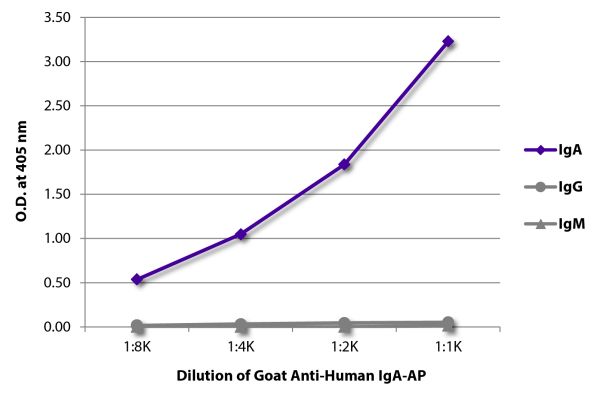

| Isotype | Goat IgG |
|---|---|
| Isotype Control | 0109-04 |
| Specificity | Reacts with the heavy chain of human IgA |
| Source | Pooled antisera from goats hyperimmunized with human IgA |
| Cross Adsorption | Human IgG and IgM; may react with IgA from other species |
| Purification Method | Affinity chromatography on human IgA covalently linked to agarose |
| Conjugate | AP (Alkaline Phosphatase) |
| Buffer Formulation | 50 mM Tris/1 mM MgCl2/50% Glycerol containing < 0.1% sodium azide, pH 8.0 |
| Clonality | Polyclonal |
| Concentration | Lot specific |
| Volume | 1.0 mL |
| Recommended Storage | 2-8°C |
| Applications |
Quality tested applications for relevant formats include - ELISA 1-5,15 FLISA Flow Cytometry 17,18 Other referenced applications for relevant formats include - ELISpot 6,7 Immunohistochemistry-Frozen Sections 8,9,13 Immunohistochemistry-Paraffin Sections 10,11 Immunocytochemistry 12 Western Blot 14,15 Immunoprecipitation 16 Multiplex 1,19 Purification 21,22 Depletion 20 |
| RRID Number | AB_2795704 |
Documentation
Certificate of Analysis Lookup
Enter the Catalog Number and Lot Number for the Certificate of Analysis you wish to view
- 1. Dasso J, Lee J, Bach H, Mage RG. A comparison of ELISA and flow microsphere-based assays for quantification of immunoglobulins. J Immunol Methods. 2002;263:23-33. (ELISA, Multiplex)
- 2. Wang J, Anders RA, Wu Q, Peng D, Cho JH, Sun Y, et al. Dysregulated LIGHT expression on T cells mediates intestinal inflammation and contributes to IgA nephropathy. J Clin Invest. 2004;113:826-35. (ELISA)
- 3. Yang M, Li F, Xie X, Wang S, Fan J. CagA, a major virulence factor of Helicobacter pylori, promotes the production and underglycosylation of IgA1 in DAKIKI cells. Biochem Biophys Res Commun. 2014;444:276-81. (ELISA)
- 4. Novak D, Svennerholm A. A comparison of seasonal variations in rotavirus antibodies in the breast milk of Swedish and Bangladeshi mothers. Acta Paediatr. 2015;104:247-51. (ELISA)
- 5. Alam MJ, Rashid MM, Kabir Y, Raqib R, Ahmad SM. On birth single dose live attenuated OPV and BCG vaccination induces gut cathelicidin LL37 responses at 6 week of age: a natural experiment. Vaccine. 2015;33:18-21. (ELISA)
- 6. Ruprecht CR, Lanzavecchia A. Toll-like receptor stimulation as a third signal required for activation of human naive B cells. Eur J Immunol. 2006;36:810-6. (ELISPOT)
- 7. Ramani S, Neill FH, Opekun AR, Gilger MA, Graham DY, Estes MK, et al. Mucosal and cellular immune responses to Norwalk virus. J Infect Dis. 2015 Jan 29. pii: jiv053. [Epub ahead of print]. (ELISPOT)
- 8. Forshammar J, Isaksson S, Strid H, Stotzer P, Sjövall H, Simrén M, et al. A pilot study of colonic B cell pattern in irritable bowel syndrome. Scand J Gastroenterol. 2008;43:1461-6. (IHC-FS)
- 9. Xu W, Santini PA, Matthews AJ, Chiu A, Plebani A, He B, et al. Viral double-stranded RNA triggers Ig class switching by activating upper respiratory mucosa B cells through an innate TLR3 pathway involving BAFF. J Immunol. 2008;181:276-87. (IHC-FS)
- 10. Rowley AH, Shulman ST, Mask CA, Finn LS, Terai M, Baker SC, et al. IgA plasma cell infiltration of proximal respiratory tract, pancreas, kidney, and coronary artery in acute Kawasaki disease. J Infect Dis. 2000;182:1183-91. (IHC-PS)
- 11. Liu D, Jiang W, Liu P. Reduction of the amount of intestinal secretory IgA in fulminant hepatic failure. Braz J Med Biol Res. 2011;44:477-82. (IHC-PS)
- 12. Suzuki H, Moldoveanu Z, Hall S, Brown R, Vu HL, Novak L, et al. IgA1-secreting cell lines from patients with IgA nephropathy produce aberrantly glycosylated IgA1. J Clin Invest. 2008;118:629-39. (ICC)
- 13. Puga I, Cols M, Barra CM, He B, Cassis L, Gentile M, et al. B cell-helper neutrophils stimulate the diversification and production of immunoglobulin in the marginal zone of the spleen. Nat Immunol. 2012;13:170-80 (IHC-FS)
- 14. Berthelot L, Papista C, Maciel TT, Biarnes-Pelicot M, Tissandie E, Wang PH, et al. Transglutaminase is essential for IgA nephropathy development acting through IgA receptors. J Exp Med. 2012;209:793-806. (WB)
- 15. Pascal V, Laffleur B, Debin A, Cuvillier A, van Egmond M, Drocourt D, et al. Anti-CD20 IgA can protect mice against lymphoma development: evaluation of the direct impact of IgA and cytotoxic effector recruitment on CD20 target cells. Haematologica. 2012;97:1686-94. (ELISA, WB)
- 16. Santiago T, Kulemzin SV, Reshetnikova ES, Chikaev NA, Volkova OY, Mechetina LV, et al. FCRLA is a resident endoplasmic reticulum protein that associates with intracellular Igs, IgM, IgG and IgA. Int Immunol. 2011;23:43-53. (IP)
- 17. He B, Santamaria R, Xu W, Cols M, Chen K, Puga I, et al. The transmembrane activator TACI triggers immunoglobulin class switching by activating B cells through the adaptor MyD88. Nat Immunol. 2010;11:836-45. (FC)
- 18. Skrede S, Steinsland H, Sommerfelt H, Aase A, Brandtzaeg P, Langeland N, et al. Experimental infection of healthy volunteers with enterotoxigenic Escherichia coli wild-type strain TW10598 in a hospital ward. BMC Infect Dis. 2014;14:482. (FC)
- 19. Gu A, Mo H, Bei J, Xie Y, Chen L, Feng Q, et al. Evaluation of antibodies against different Epstein-Barr virus nuclear antigen 1 peptides in diagnosis of nasopharyngeal carcinoma. Clin Vaccine Immunol. 2009;16:592-3. (Multiplex)
- 20. Palaia JM, McConnell M, Achenbach JE, Gustafson CE, Stoermer KA, Nolan M, et al. Neutralization of HIV subtypes A and D by breast milk IgG from women with HIV infection in Uganda. J Infect. 2014;68:264-72. (Depletion)
- 21. Janoff EN, Fasching C, Orenstein JM, Rubins JB, Opstad NL, Dalmasso AP. Killing of Streptococcus pneumoniae by capsular polysaccharide-specific polymeric IgA, complement, and phagocytes. J Clin Invest. 1999;104:1139-47. (Purification)
- 22. Meinke A, Henics T, Hanner M, Minh DB, Nagy E. Antigenome technology: a novel approach for the selection of bacterial vaccine candidate antigens. Vaccine. 2005;23:2035-41. (Purification)
See More


